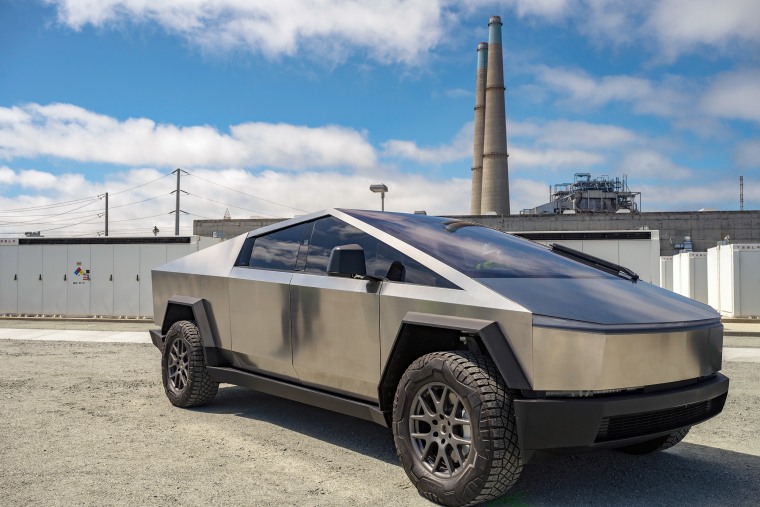As vehicles get bigger and heavier, they also get deadlier. It’s a trend that has some concerned about Tesla’s new Cybertruck, a 6,800-pound electric behemoth with sports-car acceleration that experts say will be lethal to pedestrians and occupants of lighter vehicles.
Tesla CEO Elon Musk defended the truck in an X post last week.
“We are highly confident that Cybertruck will be much safer per mile than other trucks, both for occupants and pedestrians,” he wrote.
Some in the vehicle safety world disagree.
Michael Brooks, executive director of the Center for Auto Safety — a nonprofit consumer advocacy organization — said the Cybertruck poses a variety of threats to pedestrians.
According to Tesla’s website, the Cybertruck Cyberbeast model clocks in at 6,843 pounds, and can accelerate from 0-60 mph in 2.6 seconds. For comparison, the 2023 Ford F-150 starts at slightly more than 4,000 pounds, and can go from 0-60 mph in about 5.5 seconds.
Brooks said the Cybertruck’s extreme acceleration capabilities, combined with its weight, means that drivers will have less time to react to pedestrians, and collisions with them will be deadlier.
He said the Tesla Cybertruck will be dangerous to occupants of other cars, as well.
“Just like Elon says — If you have an argument with another car, you will win — so long as ‘winning’ means inflicting life-threatening damage to other humans on the road,” Brooks said.
Tesla did not respond to a request for comment.
Concerns about vehicle safety have grown as pedestrian deaths continue to climb, reaching a 40-year high this year. Traffic deaths have also risen, with vehicle deaths per million rising in the United States in recent years as they fell in other developed countries, according to a New York Times analysis. In the first half of this year, an estimated 19,515 people were killed in traffic crashes, according to the National Highway Traffic Safety Administration (NHTSA).
Those numbers are expected to rise as vehicles follow an industry trend in which cars, and trucks in particular, increase each year in weight and size — especially as they transition to electric vehicles.
The Cybertruck falls in line with that fad.
“Vehicle weight in our fleet has continued to go up over the past 20 years,” the Insurance Institute for Highway Safety, an independent organization that gives crash test ratings to new vehicles, said in a statement to NBC News.
Cybertruck adds to a growing list of trucks on the roads that have eschewed gas-powered engines for battery-powered electricity, with competitors from Ford and Chevrolet to the upstart Rivian introducing models.
“Electrification is taking weight increases to another level that will lead to dangerous outcomes,” it added. The weight of the batteries that power electric cars can add hundreds and sometimes thousands of pounds to vehicles.
As well as being a danger to pedestrians, heavier vehicles will lead to more fatal outcomes in collisions with other vehicles, as the occupants of lighter vehicles will be crushed more easily, the institute said.
Isabella Chu, associate director of the data core at the Stanford Center for Population Health Sciences, summarized that deadly geometry.
“When you increase the weight and acceleration of any car, you’re increasing the probability of a crash due to the nature of speed, and you’re increasing the lethality of any crash that does happen,” she said.
Chu said this has led to a sort of arms race, in which “you have to have the biggest, toughest car — or you die.”
Despite these dangers, the Tesla Cybertruck has not been crash-tested by the Insurance Institute for Highway Safety or by any federal regulator.
A spokesperson for the NHTSA said it doesn’t plan to test the Cybertruck next year for its five-star safety ratings program.
That’s because it doesn’t have to. It can choose which cars, if any, it wants to crash-test.
When asked why the NHTSA doesn’t plan to test the Cybertruck, it said it tests about 86% of the new vehicle fleet — a broad cross-section that represents most automobiles on the road.
“Unlike Europe, the U.S. doesn’t require cars be tested for safety before they are allowed to be sold to the public,” said David Zipper, a visiting fellow at Harvard University’s Kennedy School whose work focuses on transportation policy.
“We let car companies decide for themselves when it’s safe,” he explained.
Some videos of crash tests featuring the Cybertruck that have circulated online appear to have taken place in Tesla’s own crash lab. In April, Tesla posted one of the crash test videos to X, the social media platform owned by Musk.
Brooks, of the Center for Auto Safety, said the vehicle’s stainless-steel construction makes him question whether it has sufficient crumple zones — usually made from plastic composites — the lack of which would increase the force upon occupants in the event of a crash.
Even if vehicles did have to be tested before being sold, Zipper said he doesn’t think those crash tests cover all the appropriate safety bases anyway.
“Right now, there’s been no crash tests done by the federal government or IIHS, but even those don’t do anything about pedestrian impacts,” he said.
Zipper said he thinks one of the first steps forward should be mandating rules about pedestrian impacts in U.S. car regulations, adding that he thinks it’s ludicrous that the country doesn’t have any, given the record-breaking pedestrian death crisis.
“I think Elon Musk in particular has shown the danger of letting automakers decide for themselves what’s safe on public roads,” he said.
